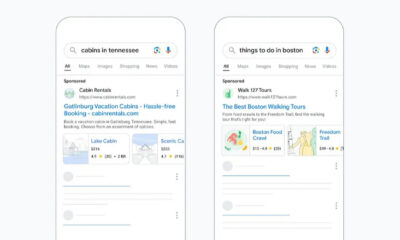SEO
9 Tips To Help Your B2B Google Ads Campaigns Shine

It comes as no surprise that when sourcing products and services, B2B customers – like the rest of the world – find them online.
In fact, 87% of B2B enterprises turn to search engines for new content.
If your target audience is the typical B2B buyer, you need to appear prominently on relevant search engine results pages (SERPs).
While SEO can certainly get you page one visibility, Google Ads are a great way to augment your organic presence – especially in super competitive results.
Challenges In B2B Advertising
There are several obstacles marketers face when setting up and optimizing B2B Google Ads campaigns.
First of all, B2B keywords are expensive thanks to the amount of competition.
Additionally, niche markets (usually B2B) often have low search volumes for many of their main keywords.
Compound that with low conversion data, and it means Google’s algorithms might not have enough data to ‘learn’ from.
Furthermore, due to most B2B products and services having a long sales cycle, attributing the true impact of Google Ads to your bottom line can be difficult.
9 Tips For Better Performing B2B Google Ads Campaigns
Whether you want to drive more traffic to your website, create brand awareness, increase leads, or launch a new product, these tips will help your Google Ads campaigns get in front of the right audience and achieve your desired results.
1. Hunt For Goldilocks Keywords
Finding “Goldilocks” keywords; that is, the ones that are not too expensive but still have sufficient search volume.
Here’s how:
- Look for broad keyword themes, but not too broad, to generate more traffic. Use a keyword planner tool to map out keywords. Look out for words with a reasonable average monthly search, then check how competitive they are, and the low and high range bids. You might have the perfect keyword but if it is too expensive, it will blow your budget out of the water and hinder the sustainability of your campaign.
- Consider keyword intent when choosing your keywords. Google honors intent, so be sure to rule out ambiguity and focus on who might be using these keywords in their search.
- Create a few keyword lists. While some suggest keyword lists should contain 20-30 keywords per ad group, this could result in your daily budget being spent too quickly and is unnecessary if your keywords are well-targeted. In fact, five well-chosen keywords per list are just fine.
2. Check Out The Competition
It is always good to carry out a competitor analysis to identify what search terms your competition is investing in.
This way, you will better understand your competition and alternatives and capture their search terms through your targeted bidding.
3. Know When It’s Okay To Be Negative
Negative keywords are important for optimizing your Google Ads for B2B campaigns.
Why? They prevent your ad from being shown (and clicked on) by people outside your target audience.
They also ensure that your ad is only shown for your niche in the industry.
For example, if you provide health insurance, your negative keywords might be other insurance products that would waste your click budget such as business insurance, life insurance, car insurance, etc.
There is also a list of commonly used negative keywords that help B2B marketers steer clear of unqualified clicks from those seeking employment, investors, and information seekers.
These include terms such as jobs, employment, recruiting, intern, free, resumes, salary, definition, example, what is, training, diagram, association, research, and many more.
4. Test And Test Again
As with all things digital marketing-related, testing is par for the course to get the best out of your campaigns. Testing between combining campaigns vs. segmenting them will give Google’s algorithm more data to learn from.
See How to Set up Profitable A/B Tests for PPC Success to learn more.
5. Diversify Your Mediums, Customize Your Audiences
Make good use of custom intent audiences based on websites and search terms in Google Display, Discover, and YouTube.
This allows your ads to reach a bespoke group of users searching for the keywords relevant to you and gives your campaigns a chance to run on potentially cheaper mediums.
6. Try Catch And Release Remarketing
Another strategy to deploy involves using a limited number of expensive keywords to drive high-quality traffic to your website.
After that, place them in tailored remarketing journeys on more affordable mediums (such as Google Display, remarketing campaigns) in a bid to convert them down the line.
7. Really Customize Your Landing Pages
After going through so much effort to fine-tune your Google Ads campaigns, it would be an absolute shame to lose the hard-earned clicks and potential leads due to a poorly designed landing page.
Invest in a specialized landing page that matches the user’s search query, has a compelling, emotive offer, and only has one call-to-action.
If you have several campaigns for several products or services, each should have its own unique landing page. In other words, don’t send your clicks to your home page!
8. Let Lead Quality Be Your Guide
Once you’ve set up your campaign with your carefully selected keywords and your leads start coming in, it is important to check on the quality of your leads per keyword.
If it is clear that better quality leads are coming from keyword A rather than keyword B, then you can confidently focus your attention, ads, and additional keywords on keyword A themes.
This can help you steer traffic in the right direction.
9. Mine That Data
When measuring ROI, it is important to use data correlation to get the bigger picture of whether your campaigns are adding value or not, rather than just focusing on what Google Ads attributes to the campaigns.
If you see an overall increase in conversions after a few weeks of running your campaigns, you can attribute this to your efforts on Google ads.
Conclusion
I wish I could say that getting Google Ads to work for B2B leads is a one-and-done activity!
But once you have finetuned your B2B Google Ads campaigns into a results-producing machine, you need to continue managing your account.
Check on your campaigns frequently and use click-through rates, conversion data, cost per click, and best-performing ads to optimize your campaigns and budgets continually.
In doing so, you will successfully support your overarching B2B marketing goals.
More resources:
Featured Image: SFIO CRACHO/Shutterstock

















You must be logged in to post a comment Login